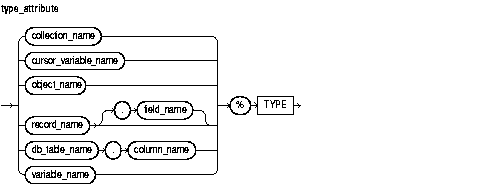Release 2 (9.2)
Part Number A96624-01
Home |
Book List |
Contents |
Index |
 Master Index |
 Feedback |
| PL/SQL User's Guide and Reference Release 2 (9.2) Part Number A96624-01 |
|
PL/SQL Language Elements, 51 of 52
The %TYPE attribute provides the datatype of a field, record, nested table, database column, or variable. You can use the %TYPE attribute as a datatype specifier when declaring constants, variables, fields, and parameters. For more information, see "Using %TYPE".

This identifies a nested table, index-by table, or varray previously declared within the current scope.
This identifies a PL/SQL cursor variable previously declared within the current scope. Only the value of another cursor variable can be assigned to a cursor variable.
This refers to a table and column that must be accessible when the declaration is elaborated.
This identifies an object (instance of an object type) previously declared within the current scope.
This identifies a user-defined or %ROWTYPE record previously declared within the current scope.
This identifies a field in a user-defined or %ROWTYPE record previously declared within the current scope.
This identifies a variable previously declared in the same scope.
The %TYPE attribute is particularly useful when declaring variables, fields, and parameters that refer to database columns. However, the NOT NULL column constraint is not inherited by items declared using %TYPE.
|
 Copyright © 1996, 2002 Oracle Corporation. All Rights Reserved. |
|